Home Office workforce diversity statistics 2019 to 2020
Published 18 February 2021
This is not the latest release. (View latest release).
Home Office responsible analyst: Adam Secret
Press enquires: pressoffice@homeoffice.gov.uk
Telephone: 0300 123 3535
Public enquiries: DIVERSITYTEAM-INBOX@homeoffice.gov.uk
This publication forms part of the Home Office’s response to Recommendation 28 of the Windrush Lessons Learned Review
“Subject to relevant statutory provisions, such as s10 Constitutional Reform and Governance Act 2010, the department should revise its Inclusive by Instinct diversity and inclusion strategy to include its aspirations for senior-level black, Asian and minority ethnic representation and a detailed plan for achieving them. Action should form part of a coherent package with ambitious success measures and senior-level ownership and accountability. The department should publish comprehensive annual workforce data, so it can monitor progress.”
When a leadership of an organisation comes from a narrow range of backgrounds, this limits the different perspectives and reduces the quality of the outcomes which might be achieved. As the Lessons Learned Review noted, an organisation that encourages diverse ideas will be more open to challenging the status quo. The Windrush Report highlighted that the lack of diversity in the leadership of the Department played a part in the failure to recognise the risks to the Windrush Generation.
The data we are publishing goes beyond the recommendation and covers broader identity categories, where possible examining representation by grade, and by different areas within the Home Office. The data we are publishing shows that despite efforts to improve, there is still underrepresentation in both the Senior Civil Service (SCS) and in the pipeline to SCS for black and minority ethnic staff. The data shows too, that staff with disabilities are underrepresented throughout the workforce.
There is much more work to be done to ensure that the Home Office is representative of the public we serve. The forthcoming revised Home Office diversity and inclusion strategy will set out our plans for improving inclusion and representation within the organisation.
1. Introduction
The Home Office employs approximately 35,000 people in a wide range of roles across the UK and overseas. These people work in one of four functions:
- Borders Immigration and Citizenship System (BICS), this encompasses staff in UK Visas and Immigration, Border Force, Immigration Enforcement and HM Passport Office
- National Security, staff in this area work to counter threats from terrorism
- Public Safety, this includes staff who support work on policing and fire and rescue services
- Enablers, this includes staff that support other functions through a variety of means, including analysis, HR, and IT
As shown in Figure 1, the majority of staff (82%) are employed in BICS. This includes a large number of operational staff such as Border Force officers and UKVI caseworkers. In contrast, National Security and Public Safety are largely made up of policy specialists. As a result of the dominance of BICS staff in the data, many Home Office level statistics are heavily influenced by the representation in BICS. To enable a clearer picture of the diversity of the workforce in the Home Office, the representation rates have been calculated at both the departmental and function levels where possible.
In the following sections, the representation of four categories of identity Home Office staff have been reported; sexual orientation, ethnicity, gender and people with disabilities. These are compared with the targets set out in the Department’s existing diversity and inclusion strategy Inclusive by Instinct, and then split out by the business functions. As part of the work the Department is doing in response to the Windrush Lessons Learned Review, we are re-developing the diversity and inclusion strategy. We will review our success measures, including SCS and all-people representation targets.
Figure 1: Distribution of staff in the Home Office, by function
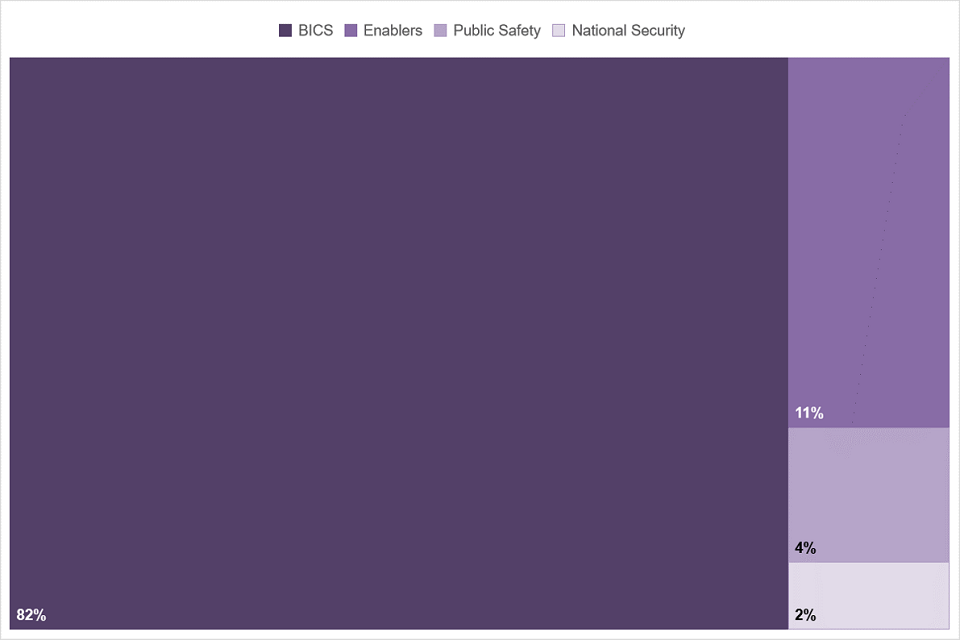
Source: Home Office
Home Office grades are summarised below. They range in ascending order from the most junior staff at AA or AO, through to Senior Civil Servant’s who hold greatest seniority.
- AA or AO: Administrative Assitant or Administrative Officer
- EO: Executive Officer
- HEO or SEO: High Executive Officer or Senior Executive Officer
- Grade 7 (G7)
- Grade 6 (G6)
- SCS (SCS1, 2, 3 and 4): Senior Civil Servant
2. Comparison to targets
The Home Office Inclusive by Instinct diversity and inclusion strategy was published in 2018. It sets out a series of representation targets for the Department to achieve by 2025. These are set out in Table 1. These targets were derived by setting them equal to either the UK economically active population or current Home Office representation, whichever was higher at the time of them being set. Since the original targets were produced the current UK working population representation rates for some groups have been refreshed, see Table 2.
There are two targets for each category of identity;
- All Staff
- a separate figure for the Senior Civil Service (SCS).
When considering the representation rates listed for 2018 and 2020, particularly for SCS, the total population size in some of the cohorts may be relatively low. An increase or decrease of just a few individuals can have a noticeable impact on the percentages reported. It is expected that there will be some variation in the representation rates from year to year, with the overall trend being the important indicator of success.
Table 1: Progress against diversity targets
| Characteristic | Grade | Target | 2018 | 2020 | |
|---|---|---|---|---|---|
| Black, Asian and minority ethnic | |||||
| All Staff | 24% | 24% | 23% | ||
| SCS | 12% | 6% | 7% | ||
| Disability | |||||
| All Staff | 12% | 9% | 9% | ||
| SCS | 5% | 3% | 8% | ||
| Women | |||||
| All Staff | 52% | 52% | 52% | ||
| SCS | 47% | 39% | 47% | ||
| Lesbian, Gay and Bi* | |||||
| All Staff | 6% | 3% | 4% | ||
| SCS | 6% | 5% | 5% |
* At the time of collecting this data, The Home Office’s Adelphi system only recorded people as either “Heterosexual, Straight” or “LGB”. The methodology for collecting data on sexual identity has been revised, see definitions for further detail.
Table 2 provides some context to the representation rates with estimates of the demographics of the UK working population:
Table 2: UK population diversity estimates
| Characteristic* | Sub-division | Percent | Date** | Geography | Note | Source |
|---|---|---|---|---|---|---|
| Ethnicity | 2011 | England and Wales | People aged 16-64 | GOV.UK | ||
| White | 85.6% | |||||
| Asian | 8.1% | |||||
| Black | 3.4% | |||||
| Mixed | 1.8% | |||||
| Other | 1.1% | |||||
| Disability | Jan-Mar 2020 | Great Britain | Economically active people aged 16-64 | GOV.UK | ||
| Disabilities defined under Equality Act 2010 | 11.5% | |||||
| Women | 2011 | UK | People aged 16-74 | GOV.UK | ||
| All women aged 16-74 | 50.5% | |||||
| Sexual Orientation*** | 2018 | UK | People aged 16-64 | GOV.UK | ||
| Lesbian, Gay or Bi | 2.7% |
* The Home Office employs people in all countries in the UK. Population estimates for ethnicity only refer to England and Wales. Disability population estimate refers only to Great Britain as the Equality Act 2010 does not apply to Northern Ireland.
** UK 2011 census is approaching 10 years old, where more up-to-date data has since been made available population estimates have been revised.
*** The higher target for Lesbian, Gay and Bi people in Inclusive by Instinct was based on estimates created for the passage of civil partnership legislation. Since then, the ONS published in 2018 experimental data on Sexual Orientation in the UK which is used as the source for this table.
2.1 Disability
Representation of disabled staff amongst All Staff has remained below target. In contrast, SCS representation of disability has more than doubled to 7.7% and now exceeds the target set in 2018. However, in both cases we are not currently representative of the UK working population.
2.2 Ethnicity
The Department has made progress in increasing its representation of black, Asian and minority ethnic people in the SCS, with representation increasing from 6% to 7%. It has declined slightly in its representation amongst All Staff, falling from 24% to 23%. This is still above the England and Wales population estimate for black, Asian and minority ethnic people of 14%.
Representation of different ethnicities in grades AA or AO - Grade 7 appear to have met or exceeded the estimates for the population (see Figure 5). At Grade 6 representation of black and Asian people was less than the population estimate. There were too few people of each individual ethnicity at SCS to show these values.
2.3 Gender Identity
At the time targets were set, data was not collected on gender identity. The Department has recently introduced an option for staff to declare their gender identity and may consider targets as appropriate in due course.
2.4 Sexual Orientation
Representation of Lesbian, Gay and Bi staff has remained fairly constant, with a small increase of 1 percentage point amongst All Staff to 4%.
2.5 Women
Representation of women also shows improvement. The Department is currently meeting its targets for both All Staff and SCS.
3. Analysis of Protected Characteristics
In this section representation of protected characteristics has been analysed in more detail. Representation has been broken down by grade and departmental function to provide more granular detail of representation in the Home Office.
3.1 Age
Figure 2: Breakdown of age by grade
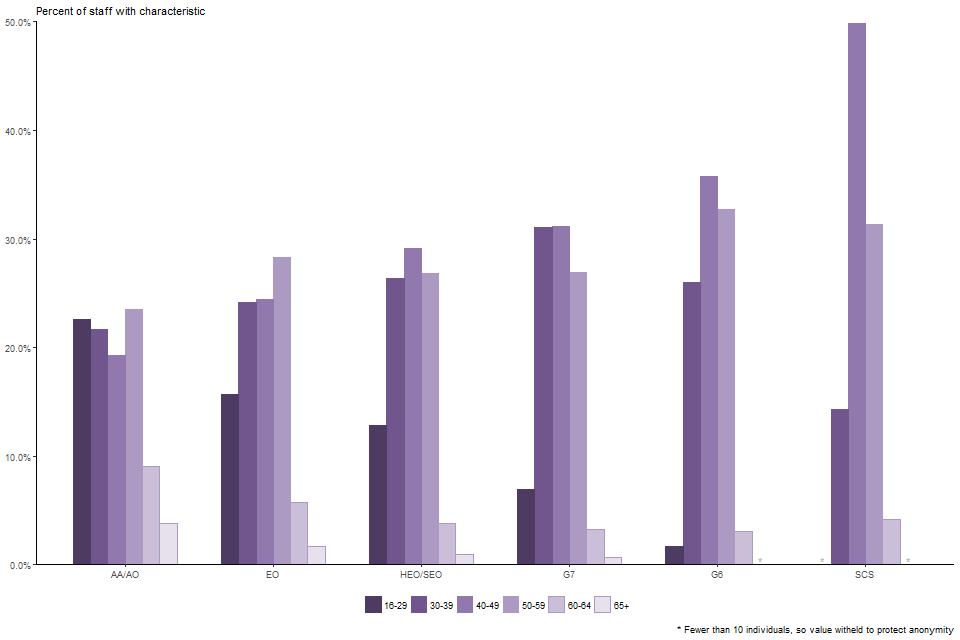
Source: Home Office
Staff aged 65 or older form a greater cohort at more junior grades, with 3.8% of AA or AO staff, 1.7% of EOs and compared to fewer than 1% of HEO or SEOs and G7s. Junior posts were also more likely to be held by younger people, with 22.6% of AA or AOs being 16-29, 15.6% of EOs and 12.8% of HEO or SEO.
3.2 Disability
Figure 3: Percent of staff with disabilities by grade and business area
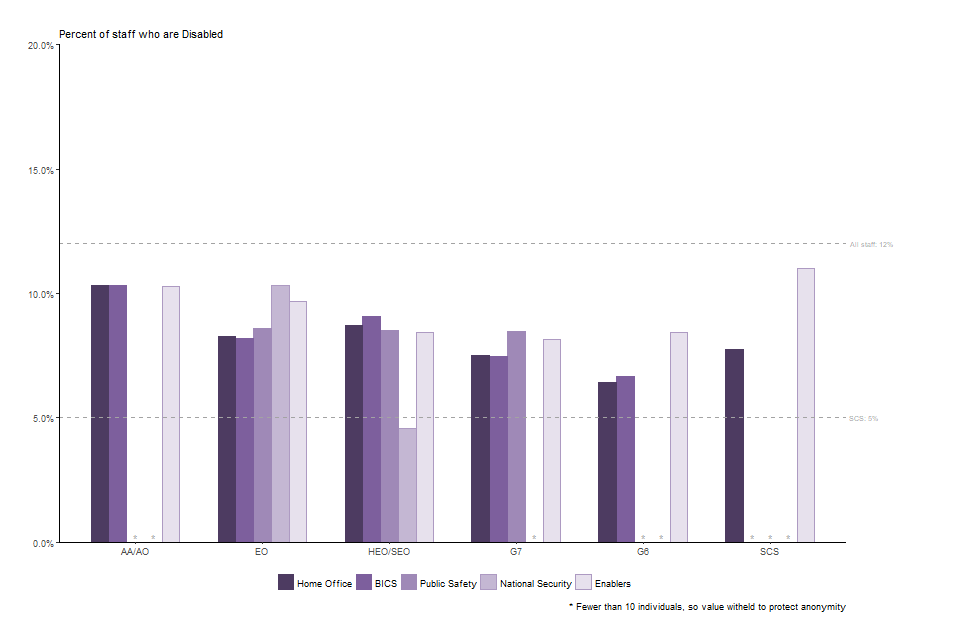
Source: Home Office
The Department is currently below its target of 12% of All Staff across all functions and grades. Representation of people with disabilities is generally higher at lower grades, with approximately 10% of AA or AO staff reporting as disabled, whereas at Grade 6 this figure is 6% of staff.
At SCS level 8% of staff reported as disabled, this exceeds the target of 5%. Representation in the Enablers function was even higher at 11%.
3.3 Ethnicity
Figure 4: Percent of minority ethnic staff by grade and business area
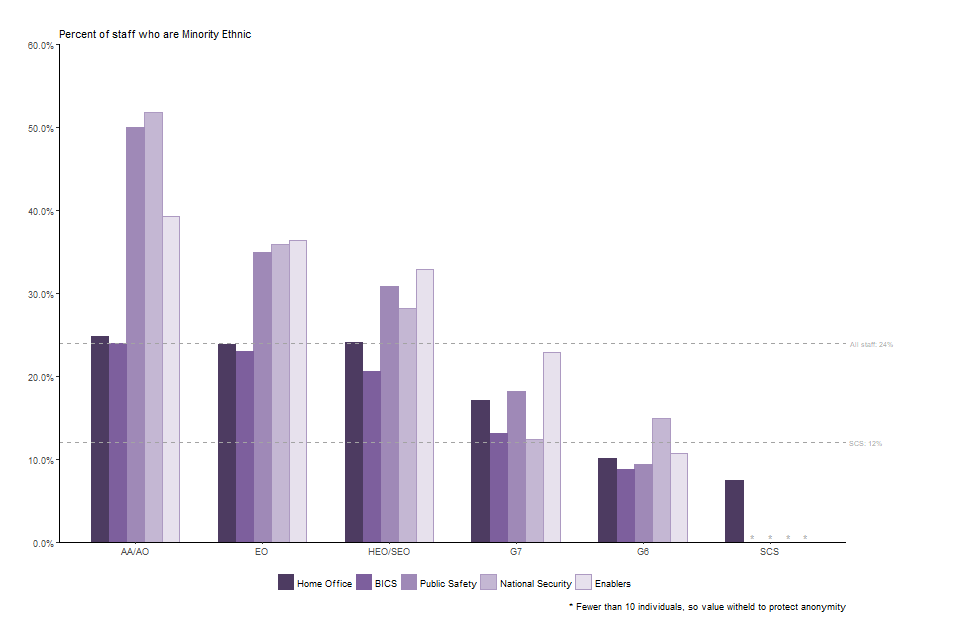
Source: Home Office
Across the organisation black, Asian and minority ethnic staff comprise a greater proportion of the workforce in the junior grades than in more senior grades. At AA or AO, EO and HEO or SEO the rate is 24.8%, 23.8% and 24.1% respectively. This contrasts with more senior grades’ representation of 17.0% for Grade 7, 10.1% for Grade 6 and 7.4% at SCS.
There is substantial variation in representation across functions, with black, Asian and minority ethnic representation in BICS tending to be lower than for other areas of the Department at the same grade. This may be because the majority of BICS staff work in operational roles, in a wide range of locations across the UK, where the local labour markets are more ethnically homogenous. In contrast, the National Security and Public Safety commands are predominantly policy functions which are mainly based in the London area and reflect the more ethnically diverse local labour market.
Figure 5: Breakdown on minority ethnicities by grade
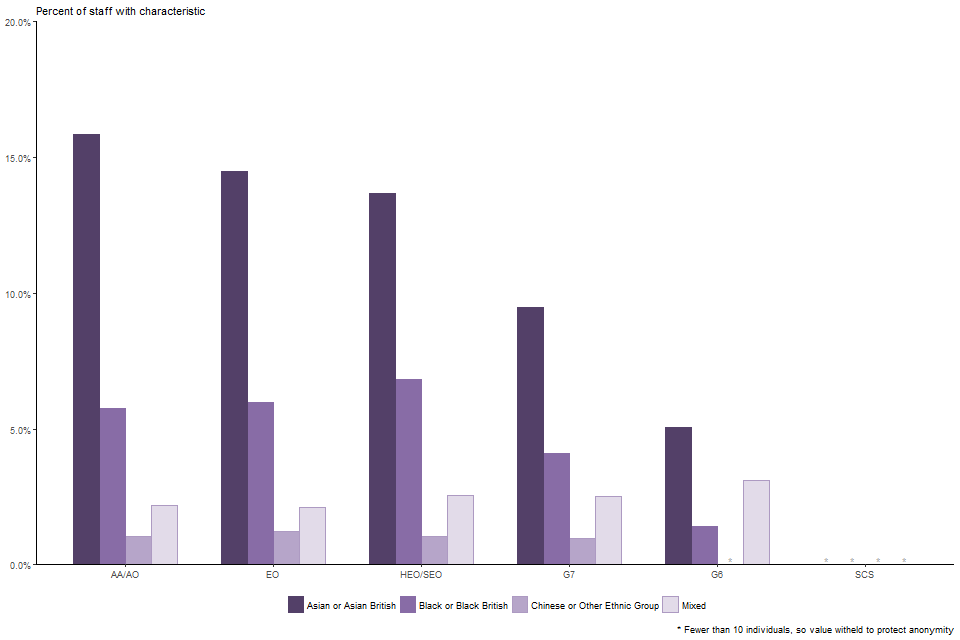
Source: Home Office
Ethnicity is also broken down into a more detailed analysis at the whole department level, excluding white. White has not been included in the chart because including it would allow the reader to deduce redacted values which have been removed to preserve anonymity.
Asian or Asian British is the most represented ethnicity, after white, across all grades from AA or AO to Grade 6. However, the proportion of staff who are Asian or Asian British decreases as the seniority of grade increases. Black or Black British is the next most represented group. Representation from AA or AO to HEO or SEO remains consistent, ranging from 5.8% to 6.8%. However, this too reduces at Grade 7 and above.
Representation of Mixed and Chinese or Other Ethnic Groups is more equal across grades AA or AO to Grade 7, ranging from 1.0% to 1.2%. There were too few individuals at Grade 6 and SCS to report on these ethnicities at those grades.
3.4 Religion and Belief
Figure 6: Breakdown of religion and beliefs by grade
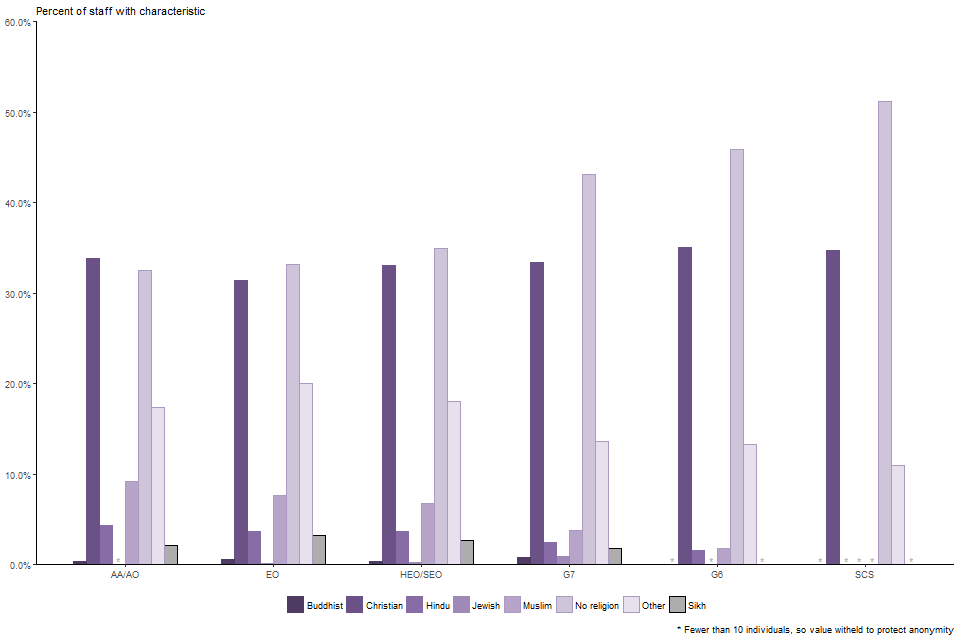
Source: Home Office
For all grades except AA or AO, the most frequently reported religion or belief was No Religion. The percent of people repoting No Religion increased with the seniority of each grade, at AA or AO this was 32.5% but rose to 51.2% at SCS. The next most frequently reported religion or belief was Christian. The proportion of people reporting as Christian was similar across the grades, ranging from 31.4% at EO to 35.0% at Grade 6.
No Religion and Christian constituted the majority of respondents across all grades. In all cases, the next most popular responses were Other and Muslim.
3.5 Sexual Orientation
Figure 7: Percent of lesbian, gay and bi staff by grade and business area
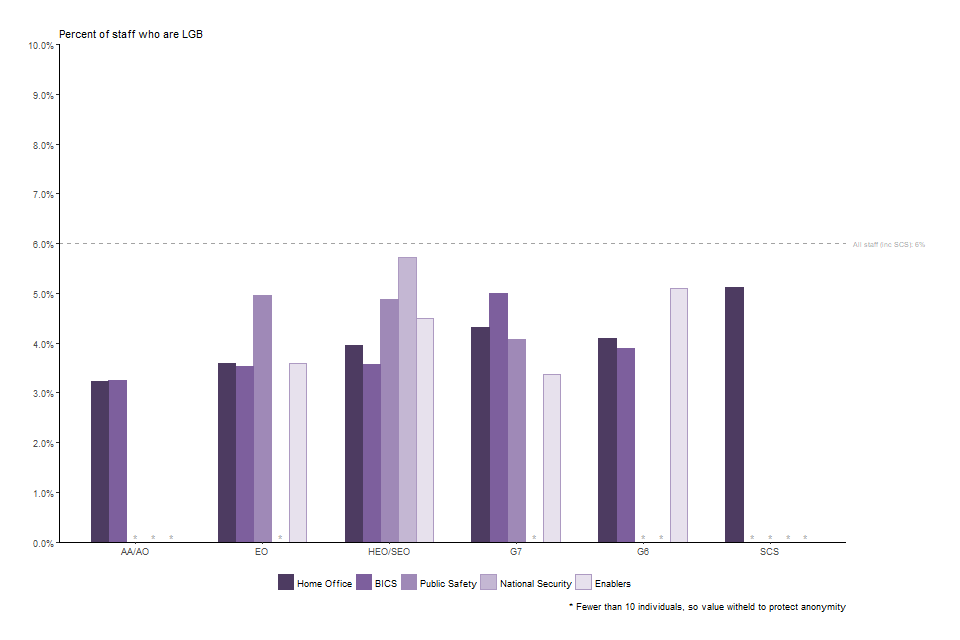
Source: Home Office
No function in the Department, at any grade, has achieved the target of 6% representation of Lesbian, Gay or Bi staff. However, some functions at some grades were close to reaching this target and are within 1 percentage point of doing so. Most notably HEO or SEO in National Security, where representation was at 5.7%.
Across the Home Office, representation appears to be greater at more senior grades, with 5.1% representation at SCS. In comparison, 3.2% of AA or AO staff reported as LGB.
3.6 Women
Figure 8: Percent of female staff by grade and business area
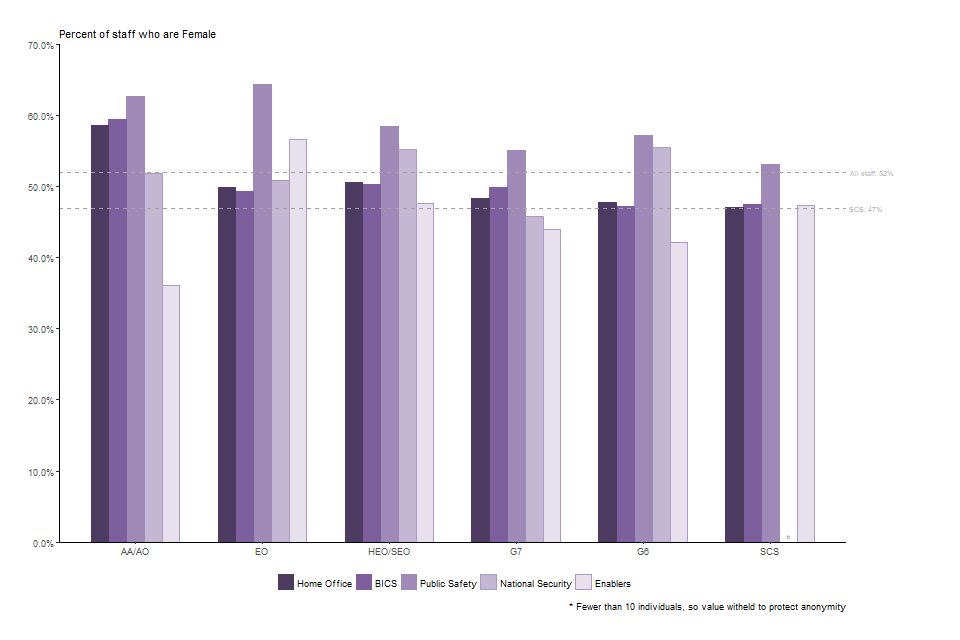
Source: Home Office
Whilst the Department is currently meeting its target for the proportion of women in the SCS and amongst All Staff, this picture is not consistent across grades and functions. Women are generally more represented at AA or AO, with 58.6% of staff across the Department. However, at grades EO (50.0%), HEO or SEO (50.6%), Grade 7 (48.4%) and Grade 6 (47.8%), representation is consistently under the 52% target.
In the SCS, all functions where there were enough individuals to publish figures, met the 47% target. The greatest representation is in the Public Safety function, where 53.1% of staff were female.
4. Data Sources
Data for this analysis was extracted from the Department’s Adelphi system for the period 1st April 2019 to 31st March 2020. It excludes anyone who left in the period and non-paid staff. The majority of the data that has been used is self-reported by staff through the Department’s Adelphi central system for human resources. In 2020 this system was replaced by Metis which included increased options for gender identity. Self-reporting is voluntary, and therefore does not provide a complete picture of the diversity of the Home Office workforce, as some staff do choose to withhold information through the “Prefer Not To Say” response. Others may not have been surveyed, so no data are available for them, this is particularly true of overseas staff for whom we only have gender. There may also be individuals who misreport, either through accident or design. While this is considered unlikely to be widespread, where percentages are very low, a small number of individuals would have noticeable impacts on the results.
The Department continues to explore how to improve its declaration rates, for example by making improvements to the categories an individual can self-define as, as well as consistent messaging on why data is needed, what it is used for, reassurance on data security, how data it is stored and anonymity protection.
4.1 SCS data
Data for SCS in the Department is extracted from the Adelphi system. This is different to the data used in the Civil Service Diversity and Inclusion Dashboard, which uses the Cabinet Office SCS database. Therefore, representation rates calulated here may differ from those caluclated elsewhere which use alternative data.
5. Method
Representation rates have been calculated by excluding individuals with unknown characteristics. These include, not being surveyed or responding with “Prefer Not to Say”.
The representation rate is then the proportion of people identified as having a specific characteristic (e.g. Female) as a proportion of all people with an identified characteristic (e.g. sum of all people identified as Male or Female).
In the analysis of representation, where the number of individuals with a characteristic is fewer than 10, the value has been removed and marked with an asterisk *. Fewer than 10 individuals indicate that either representation is very close to 0%. Or, that the population of people with a disclosed characteristic (e.g. Ethnicity, Age, Gender etc.) is so small that representation rates are heavily influenced by individual people and don’t provide a reliable narrative of the bigger picture.
5.1 Rounding
Data may be rounded to simplify the presentation of the figures. However, all numeric and percentage calculations are based on unrounded data. Where rounding has been used, totals and sub-totals have been rounded separately and so may not equal the sums of their rounded parts.
6. Definitions
6.1 Disability
The Equality Act 2010 defines disability as a physical or a mental condition which has a substantial and long-term impact on your ability to do normal day to day activities.
The Home Office Adelphi HR system asked staff the question “do you have a disability?”. The Equality Act definition was not provided, and therefore there may be some under-reporting.
6.2 LGB - Lesbian, Gay, Bi
The Home Office’s Adelphi system recorded people as either “Heterosexual, Straight” or “LGB” or “Prefer Not to Say”. In 2020 the Department introduced the new Metis reporting system which replaces Adelphi. This provides a much broader set of categories a person can choose to self-identify as for their sexual orientation. Future reporting will reflect this.
7. Further information
7.1 Forthcoming statistical releases
The next release of these statistics will be in Q2 of 2022.
Forthcoming publications are pre-announced on the statistics release calendar on the GOV.UK website.
7.2 Feedback and enquiries
We are always looking to improve the accessibility of our documents. If you have any issues accessing the information you require, or you think we’re not meeting accessibility requirements, please contact us by email: DIVERSITYTEAM-INBOX@homeoffice.gov.uk
